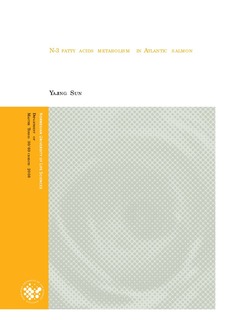| dc.description.abstract | Background: The main human dietary source for n-3 highly unsaturated fatty acids (HUFAs) is fish and seafood. In farmed fish, n-3 HUFA content has been reduced because of increased pressure to replace fish oil by vegetable oils in aqua-feeds. Recently a strategy combining genetic selection with changes in diet formulations has been proposed to improve n-3 HUFA content in farmed Atlantic salmon. n-3 HUFA composition has been shown to be a heritable trait in Atlantic salmon. Further, genes involved in the HUFA biosynthetic pathway in Atlantic salmon can be regulated by fatty acids in the diet. Therefore, the aim of this study was to investigate if variation exists, in the expression of genes regulating the n-3 HUFA biosynthesis pathway, between different Atlantic salmon families. Further, we wanted to study the influence of different levels of oleic acid (OA, 18:1 n-9) and docosahexaenoic acid (DHA, 22:6 n-3) on n-3 fatty acid metabolism in hepatocytes.
Result: Liver samples from 1044 salmon from 103 families (ca 10 fish per family), were analysed for ∆6fad gene expression. Of this, twelve families were analysed for EPA and DHA composition. The results showed that the gene expression levels of ∆6fad_b were differently expressed between the families. According to this difference, 6 families of Atlantic salmon were selected as “high expression families” and 6 families were selected as “low expression families”. The levels of the n-3 HUFAs DHA and eicosapentaenoic acid (EPA, 20:5 n-3) although not significant, were slightly higher in “high expression families” than in the “low expression families”. Atlantic salmon hepatocytes were isolated and pre-incubated with increasing ratios of DHA/OA (100 OA, 75OA/25DHA, 25OA/75DHA) in order to change the intracellular level of these fatty acids. Then the hepatocytes were incubated with radio-labelled [1-14C] 18:3 n-3. After incubation the main radio-labelled products were the desaturation product 18:4 n-3 and the desaturation and elongation products EPA, DHA and 22:5 n-3. Increasing OA content in incubation media led to a significant increase in the production of radio-labelled EPA. Radio-labelled DHA showed a tendency to be higher in the 100OA and 75OA/25DHA groups than in the100DHA and 25OA/75DHA groups.
Conclusions: The in vivo results showed that Atlantic salmon families have different expression levels of the Δ6fad gene which possibly influences the capacity to produce n-3 HUFA. The in vitro study results showed that pre-incubation of salmon hepatocytes with increasing ratios of OA may increase the EPA and DHA synthesis. | no_NO |
